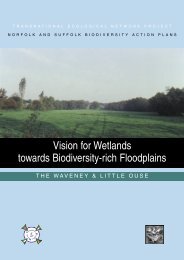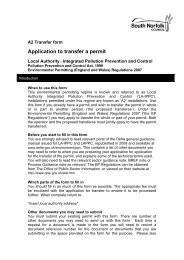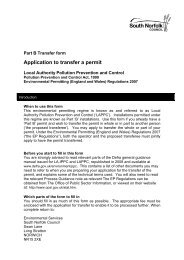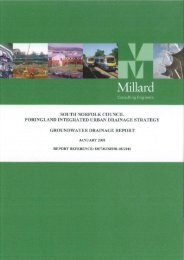Tiffey Valley Guide [PDF, 1,450k] - South Norfolk Council
Tiffey Valley Guide [PDF, 1,450k] - South Norfolk Council
Tiffey Valley Guide [PDF, 1,450k] - South Norfolk Council
Create successful ePaper yourself
Turn your PDF publications into a flip-book with our unique Google optimized e-Paper software.
FLORA & FAUNA OF THE VALLEYThe <strong>Tiffey</strong> flows through a shallow valley with graveldeposits, springs, and meadows liable to flooding. Itacts as a corridor for birds and other animals, and watervoles, though nationally in decline,use much of its length.Silfield Nature Reserve is rich inwildflowers in spring and summerand supports an exceptionalnumber of dragonfly species.Ponds and old gravel pits haveproved a good breeding groundfor frogs, toads and newts.Further downstream, lady’sBanded demoisellesmock on the wet meadows supportthe beautiful orange tip butterfly.In the drier parts of the Lizard there are harebells in summer.Herons and kestrels are often seen upstream of the town.Flowering plants on Toll’s Meadowinclude marsh marigold, marshorchid and moschatel. Theplants support diverse insectlife, snails, beautifullymarked spiders andthe birds that feed onthem. The tiny wren andflocks of tits and finchesfrequent the bushesand trees. Kingfishersregularly patrol the valley.The adjacent cemetery,with its Scots pines, is afeeding area for goldcrest,mistle thrush and greatspotted and green woodpecker.Sothern MarshOrchidTo the north west, grazing meadows provide opportunities for tawnyand barn owls to hunt for shrews, mice and voles. Here a strikingdamselfly, the banded demoiselle, perches on the plants. Whenthe fields are flooded they attract ducks and other water fowl.Clumps of mistletoe are found high in the trees towardsKimberley and there are Egyptian and other geese in the park.


![Tiffey Valley Guide [PDF, 1,450k] - South Norfolk Council](https://img.yumpu.com/41615145/4/500x640/tiffey-valley-guide-pdf-1450k-south-norfolk-council.jpg)
![List of outstanding appeals against planning decisions [PDF, 30 Kb]](https://img.yumpu.com/51294693/1/190x135/list-of-outstanding-appeals-against-planning-decisions-pdf-30-kb.jpg?quality=85)



![Brown bin calendar - week 2 [PDF] - South Norfolk Council](https://img.yumpu.com/49352110/1/184x260/brown-bin-calendar-week-2-pdf-south-norfolk-council.jpg?quality=85)




![Link magazine, Spring 2008 [PDF, 4,450k] - South Norfolk Council](https://img.yumpu.com/43994858/1/184x260/link-magazine-spring-2008-pdf-4450k-south-norfolk-council.jpg?quality=85)

![South Norfolk Council Volunteering Opportunities [PDF]](https://img.yumpu.com/42079564/1/184x260/south-norfolk-council-volunteering-opportunities-pdf.jpg?quality=85)
![Queen's Diamond Jubilee Fund [PDF] - South Norfolk Council](https://img.yumpu.com/41088331/1/184x260/queens-diamond-jubilee-fund-pdf-south-norfolk-council.jpg?quality=85)
